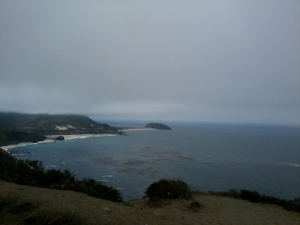
Fill up here. Next broadband sixty miles.
California’s rocky, tide-lashed Big Sur coast has tenuous electronic connections to the outside world. At its northern end, there’s an old navy listening post at Point Sur that now serves as, among other things, a cellular site. Head south, though, and it’s more than sixty miles before you’ll see modern telecoms facilities.
AT&T keeps copper-based phone service working for most of the scattered businesses and homes along this isolated stretch of State Route 1. The line threads the coastline, running underground along the state right of way for a few miles, popping up onto small poles for a stretch, then diving underground for another stitch. Fire is a danger, but the real threat is the Pacific Ocean’s constant erosion. The route is a patchwork of bridges, retaining walls and fresh asphalt marking where the road has slipped into the sea. It’s expensive enough to keep the line intact; the cost of upgrading it would be astronomical.
At one point, there was a plan to run a submarine cable just offshore, but California’s environmental and coastal development restrictions stopped it cold.
Satellites provide the most reliable, if expensive and tightly metered, broadband service. The Esalen Institute, for example, is dotted with dishes – WildBlue, HughesNet, even an old SpaceNet terminal. There’s also a microwave antenna aimed generally in the direction of Point Sur, to the north.
Fixed wireless links have been installed with varying degrees of success for individual businesses or small groups of homes. A credible, coordinated approach has never been tried. A well-engineered network, using licensed spectrum, could be built if the contentious and cantankerous interests are reconciled. But the U.S. Forest Service’s mountain tops, the California Coastal Commission’s shoreline domain, facilities owned by utilities and government agencies, and private property would have to be woven together.
Which is the problem. Wireless broadband along the Big Sur coast is a story of turf wars, nimbys and tin foil hats. Engineering a solution is the easy part.
